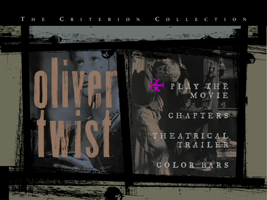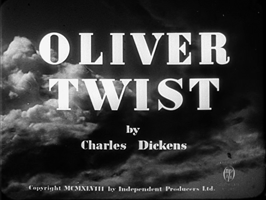directed by David Lean
screenplay by David Lean and Stanley Haynes
after the novel by Charles Dickens (1838)


Criterion #32.
A movie like beautiful illustrations. Some of the richest black-and-white tone I’ve ever seen, like a charcoal sketch. Even in the title screen above you can see it. The opening storm sequence, with its few bold expressionist strokes, is as fantastical as anything off the Alexeieff/Parker pinscreen.
But of course, this sort of thing alternates through the film with the rather conventional dialogue scenes. That’s the David Lean way, it seems: like an old N.C. Wyeth edition, there are always a few wonderful “plates” but in between it’s no different from any other grown-up book without pictures. (That’s unfair to David Lean, grown-ups, books, and me, but you get the idea.)
If you aren’t aware, Oliver Twist is a beloved story about a meek little boy born into a horrible world of child abuse from which the only escape is deus ex machina. The plot basically consists of a small child suffering, and then getting away only to find himself suffering in some new way. I know this is a classic case of critic’s toothache syndrome, but on the day I watched this movie I couldn’t for the life of me figure out why that’s a story people enjoy. (I just coined “critic’s toothache syndrome” but surely the meaning is clear.) Dickens meant it as political propaganda; it’s not all that different from those magazine ads with a big third-world harelip. Come on guys, I was reading that!
Except with Oliver Twist Dickens isn’t just throwing it in your face; he’s drawing you in with his whole voluminous bag of manipulation tricks. The whole time, we’re compelled into heartily root-root-rooting for this poor little kid not to get abused any more. “Yeah, run away!” “Yeah, beat up that mean kid!” “Boo, adults!” “Boo, London!” “Boo, world!”
Toward the end I realized that my problem was mostly the result of failing in my quest to watch everything like a kid. It all would have gone down smoothly enough if I had only “empathized,” which is a pleasant form of playing along, rather than empathized, which is grueling and a waste of time.
But whether it was the movie or the toothache I don’t know. For all I know it might actually have been the movie. Beth watched it with me and she said she felt worn out for the same reasons. But of course that’s her way. It isn’t always mine, or at least so I thought.
Alec Guinness with a false nose is Fagin the horrible horrible Jew, though unlike the novel the script does not explicitly indicate that he is Jewish. I mention it only because there it is and it was apparently controversial on the original release (Criterion boasts that they are restoring 12 minutes of his performance that were excised for later releases). I certainly don’t take it personally nor do I think that a movie like this poses any real danger in the present day, which is not to say that this isn’t fine material for forming a nice ugly stereotype if shown to the right people at the right age. But what isn’t? Certainly everyone else in Dickens is. I feel like my current mildly enlightened, mildly bigoted perspective on the varieties of man is really just a heap of stereotypes that have been subjected to erosion. Isn’t that all anyone has to work with? I have Fagin in there just like everyone else.
Robert Newton as Bill Sykes oddly gets top billing. Apparently this is the role that “made” Alec Guinness, to some degree anyway, so his name wasn’t yet a selling point. In fact the preview introduces him by explicitly reminding you that you saw him in Great Expectations, and which one he was, saying something like “who could forget Alec Guinness?”. The kid in the title role does a fine job though it’s mostly one of looking pathetic. He is clearly the prototype for the casting of Chocolate Factory Charlie. Kay Walsh shrieks a little too hard, is a little too pretty and put together for the part, and is David Lean’s then-wife so it all fits together. Francis L. Sullivan continues to have the biggest face in movies. Speaking of which, this funny face was in there very briefly and I racked my brain trying to figure out where I’d seen it. Peter Bull, a quintessential “hey it’s that guy.” Having looked him up, I think Dr. Strangelove must be my answer.
The music is that rare thing: a movie score by a famous “serious” composer. Well, as famous as Sir Arnold Bax, anyway. It has the standard strengths and weaknesses of the species: it is significantly classier and more aesthetically refined on its own terms than most movie music, and it is also never entirely apt. Film scoring is a special skill and it’s not necessarily a very arty one. This isn’t an exceedingly arty score but it’s arty enough to miss the mark. Or rather, to stubbornly set a mark that isn’t quite the same as the film’s mark.
My music selection here is a little unorthodox SO BRACE YOURSELVES. I’ve chosen a cue from the middle of the movie that has a fair amount of foley throughout (doors shutting, crying, a rooster crowing, etc. etc.) even though this movie offers a standard Main Title with no such offending sound effects. The reason is that the Main Title music doesn’t give much of a sense of the distinct voice of this score, nor does it offer the main theme in a clear and direct way. Whereas this cue (known on the soundtrack as “Oliver’s sleepless night”) does. This cue also features the concertante piano that is a particularly distinctive occasional feature of the score (played by Harriet Cohen, with the Philharmonia Orchestra under Muir Matheson). Choosing this cue over the Main Title seemed inevitable to me after I saw that the short concert suite Bax put together from the score has this cue as its first movement and gives it the title “Theme.”
Without further ado: here it is.
These are the sounds of Oliver having been sent to his room in the undertaker’s house (where he sleeps under a coffin) closing the door, crying to himself, and then later, at dawn, sneaking out before anyone wakes up and running away to London. The piano concerto texture was reportedly suggested by Lean himself as a way of suggesting Oliver’s delicate soul against the whole cruel world. In absence of the picture it sort of does that. With the picture it starts just to seem like some odd classical music is playing. Occasionally to interesting effect, occasionally not.